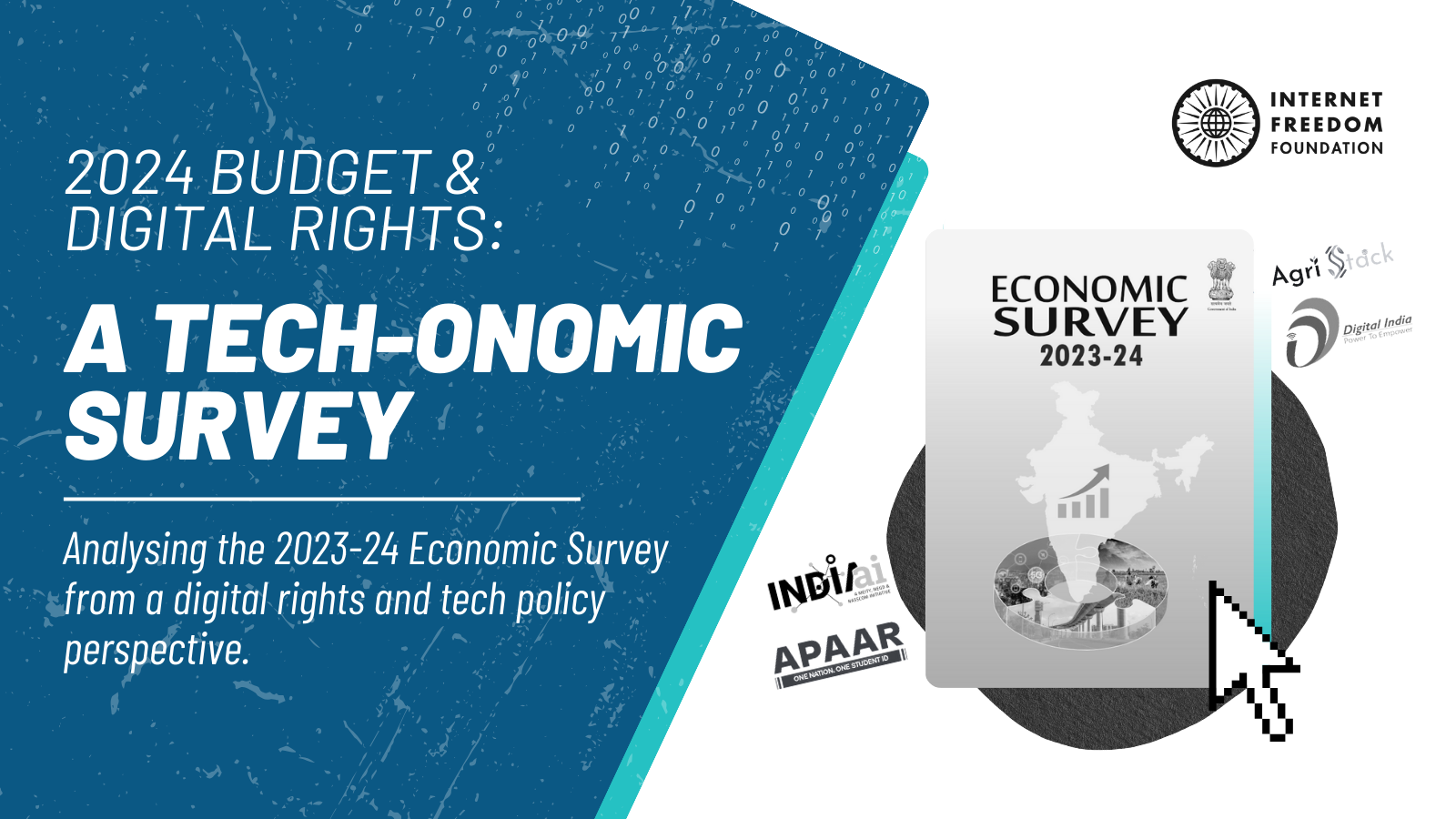
tl;dr
The latest Economic Survey attempts to encapsulate the state of the Indian economy over the past year, but for the most part echoes the praise for DPIs and techno-solutionism that has become commonplace for Indian leaders and government departments to push for in recent years. In this post, we look at what the survey has to say about DPIs generally, India’s AI mission, AgriStack and tech in agriculture, and lastly, IFF’s top contender for most opaque and lawless policy initiative, the APAAR ID.
Important documents
- The 2023-24 Economic Survey dated June 2024. (Link)
- IFF’s Feedback/Response on the Interim Report ‘Leveraging DPI for Safe and Inclusive Societies’ dated June 30, 2024. (Link)
- IFF’s posts on AgriStack. (Link)
- IFF’s post on APAAR ID. (Link)
Background
Annual economic surveys summarise key policy interventions and economic growth of the country for the past year. The 2023-24 Economic Survey (“survey”), sprawling over 500 pages, is a similar attempt but also predominantly highlights India’s move towards a fintech nation and an increased adoption of technology in the financial sector. This post will break down and analyse the survey from a digital rights perspective, covering what the survey had to say about DPIs, AI, technology in the welfare sector, digital inclusion, APAAR ID, and some miscellaneous themes.
How the survey views key digital rights issues
On digital public infrastructure
The survey points to an increasing reliance on digital public infrastructure (“DPI”) and identifies it as a stepping stone for India’s economic growth. It states that Aadhaar has “drastically reduced” operational costs for user authentication and the likes of e-KYC, Aadhaar-enabled Payment System, UPI, Bharat QR, DigiLocker, e-sign, Account Aggregator, Open Network for Digital Commerce can be leveraged by players to “ensure optimum outcomes”. The survey notes that adoption of DPIs has “brought transparency, scale operation and timely delivery of financial services to the public.”
A fundamental issue with DPI, which we explored at length in our submissions to the UNDP Working Group on DPI Safeguards, is the lack of transparency and accountability in its governance frameworks and operations. DPI, the way India interprets it, is built on public-private partnerships or provisioning models, and is deployed in the public sector to reach a maximum possible population cover. By keeping private partners, government instrumentalities can evade accountability and transparency requirements that do not similarly extend to the private sector. By keeping government partners, private entities may be able to benefit from exemptions reserved for government instrumentalities under various Indian laws, such as certain provisions of the Digital Personal Data Protection Act, 2023 (“DPDPA”).
For instance, Digi Yatra has been operationalised through a private company created for this purpose, Digi Yatra Foundation. Despite it being a government-backed initiative and identified as a DPI, citizens do not have comprehensive channels to seek grievance redress, nor can they seek transparency on the system under the Right to Information Act, 2005 as the Foundation is a private entity. Read more about our concerns with the governance framework here. Given the scale of the project and the sensitive nature of data DPI projects collect from Indian citizens, such non-transparency and poor governance framework is a glaring cause for concern and a tangible risk which has not been addressed in the survey.
There is no anchoring law, policy, or act of Parliament governing such vast public systems or providing baseline safeguards—like grievance redress mechanisms—for most DPIs operational in India today. There is little publicly available critical and human rights analysis on the infrastructure, and the success or efficacy of such mixed models in provisioning state functions is yet to be convincingly demonstrated in the Indian academic space. This gap in knowledge, juxtaposed with a strong push and rapid deployment of the mixed systems in India, is worrisome and needs to be assessed in detail.
On the IndiaAI mission
The survey outlines several government initiatives on artificial intelligence (“AI”)—Future Skills Prime, YUVAi, and Responsible AI for Youth 2022—all comprising the IndiaAI Mission, for which a budget of ₹10,300 crore has been provided this year. Despite a sizable budget allotment, the survey is interestingly right in pointing out the adverse effects of thrusting AI solutions in a society.
First, the survey heavily refers to AI as “an energy guzzler”, stating that even as developed nations favour carbon tax regimes to fight climate change, their adoption and reliance on AI is “ramping up energy demand like never before.” The survey painstakingly explains how damaging AI can prove to be for the climate, calling it an ‘ultimate irony’ how as “developed nations obsess over prospective emissions from the developing world, the widespread adoption of artificial intelligence is going to result in the demand for power to expand to levels not seen in decades.” Calling AI a “warped priority” of advanced economies, it states that AI adoption can come at the cost of economic growth for developing nations. Even AI data centres, the survey notes, are ramping up energy demand. But most amusingly—it offers this critical analysis without applying it to the Indian scenario. India is ramping up its AI mission—setting up data centres (centres of excellence), integrating AI in governance and welfare mechanisms, and incentivising public and private players to participate. India’s drive to emerge as a global leader in AI is carefully orchestrated and widely documented. Yet, not much criticism can be seen about adverse effects of AI on a rapidly deteriorating climate. The survey also calls accelerated AI adoption “the biggest disruption for the future of work” and notes that India would “not remain immune to this transformation.” The ultimate irony, indeed!
Digitalising agriculture
The survey places heavy focus on DPI integration and technology use in the agricultural sector. The ‘Digital Agriculture Mission 2021–2025’ aims to modernise agriculture through advanced technologies like AI, remote sensing, drones, etc. Further, per the Budget Announcement for 2023-24, the DPI plan spans information services for crop planning and health, improved access to farm inputs, credit, and insurance, help for crop estimation, market intelligence, and support for growth of agri-tech industry and start-ups. ‘
AgriStack is a prominent DPI with three foundational registries (databases): Farmers’ Registry/Database, Geo-referenced village maps and the Crop Sown Registry/ Database, along with several Support Registries/Databases (read our AgriStack primer here). The 3 foundational Registries and DPI interventions in agriculture also encompasses data collection, including but not limited to personal details, profile of land held, production details, and financial details. All through this digitalisation attempt, farmers have been left out of the policymaking process. When news emerged about the Agristack, farmers were not consulted. The composition of the Task Force for the development of the DPIs also reflect the lack of farmer representation. Read our joint statement on the matter here.
A number of issues have continued to plague this domain. At the outset, consultation papers for policy implementation, if any, have been in English and full of jargon. Interventions like these require long term study and constant engagement through vernacular modes and implementation frameworks to assist better understanding emerging from farmers groups across the country. Farms generate a huge amount of data in their daily operations, and so are fertile ground for exploitation by agritech and fintech firms. There is notable lack of farmer consent in the system, especially one that heavily relies on data and platformisation of routine agricultural processes. Despite the fact that the DPDPA mandates consent in processing personal data, farmers have not been informed or even involved in the conversation so far. MoUs signed by the Ministry of Agriculture with giant tech platforms and companies without due transparency exacerbate these concerns. The list of concerns with tech interventions in agriculture is currently long, but the survey does not address any. As the industry and ministry stakeholders continue to push for the AgriStack and other DPIs in agriculture, we worry that farmer welfare, data privacy, and autonomy, will be increasingly undermined. Read IFF’s analyses of AgriStack for more.
On APAAR ID
The survey calls the National Credit Framework (“NCrF”), announced under National Education Policy 2020 “the bulwark of the regulatory architecture underpinning life-long learning.” Hailed as a prime DPI, the Automated Permanent Academic Account Registry (“APAAR”) ID is a part of NCrF being said to “bolster the regulatory architecture”. APAAR aims to issue unique IDs to students based on their Aadhaar number. An APAAR ID is a life-long longitudinal record of a student’s educational scores, achievements and related statistics, and is deemed voluntary. The survey states that with the data consent layer built into these DPIs, students can leverage this architecture for employment gains. However, there are a few flaws with this argument.
First off, we wonder how APAAR will “bolster the regulatory architecture” when it itself is not tethered to a law, policy or implementation document. In our attempts to find the policy implementation plan, we filed an RTI request with the Ministry of Education seeking a specific document titled “Schooling: Access and Quality” which had supposedly been presented by the Minister of Education at the National Conference of Chief Secretaries held in New Delhi on December 28-29, 2023. This simple RTI has been transferred 26 times (!!!) between various departments within the Ministry in the past four months since it was filed. Just one document….
Additionally, contrary to what the survey believes, the APAAR framework is not adequately rooted in consent. As a scheme that is ‘voluntary’ on paper, it seems to be following in the footsteps of its grandparent, the mysterious Aadhaar, in actually being ‘mandatory’ in practice. To start with, the Ministry of Education had urged states to tell schools that they must adopt the APAAR framework and suggested they hold “special PTMs” to get parents to sign off to this. So, APAAR ID is voluntary on paper but pretty mandatory for schools to follow. Then, educationists believe that, much like Aadhaar verification, schools will be forced to ensure the participation of all students and parents. Teachers also think APAAR will eventually be thrust on them as an administrative overhead.
Even if it becomes mandatory for schools, APAAR is, again at least on paper, optional for students (and parents, whose consent is paramount to enrol them). Consent being taken from parents does not seem to be free or informed, but rather a mere formality. Some parents have pointed out that there is no option to deny consent on the Aadhaar consent form handed to them as part of the APAAR enrollment. To make matters worse, this is also harshly juxtaposed by the reality that millions of rural, nomadic, destitute, or marginalised students do not have access to education or are thrown out of schools for not possessing an Aadhaar card. By making rural schools implement an Aadhaar-based student ID, there is a risk of vast exclusion. At present, much like its foundational Aadhaar, the APAAR framework holds a *voluntary on paper, mandatory in practice* status which will only get more pervasive in the coming years as the Ministry guns for 100% implementation by 2026-27. Read about our ongoing efforts to gather comprehensive information about the APAAR ID here.
Under such circumstances, the survey’s tall claims and praise for APAAR ID seems hollow and incomplete without a deep impact analysis of how (terribly) it is actually panning out to be.
This post has been drafted with research support from Anjney Mital, Digital Literacy Intern, and Injila Zaidi, Freedom Innovation Fellow, Internet Freedom Foundation.

